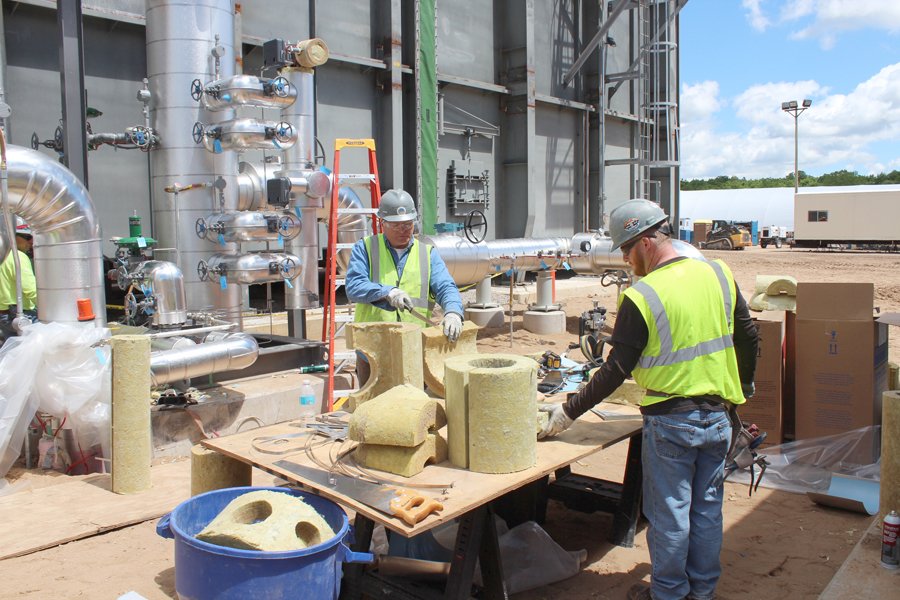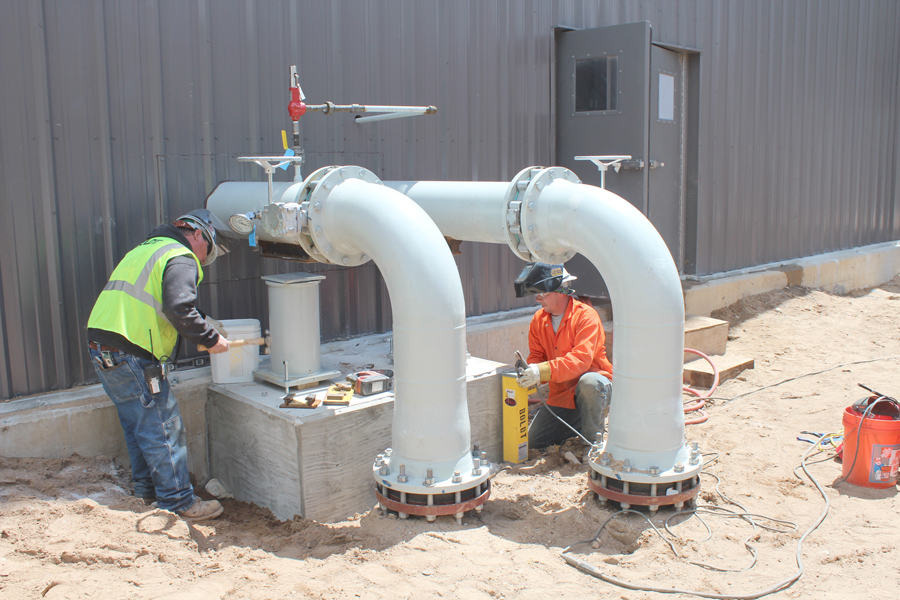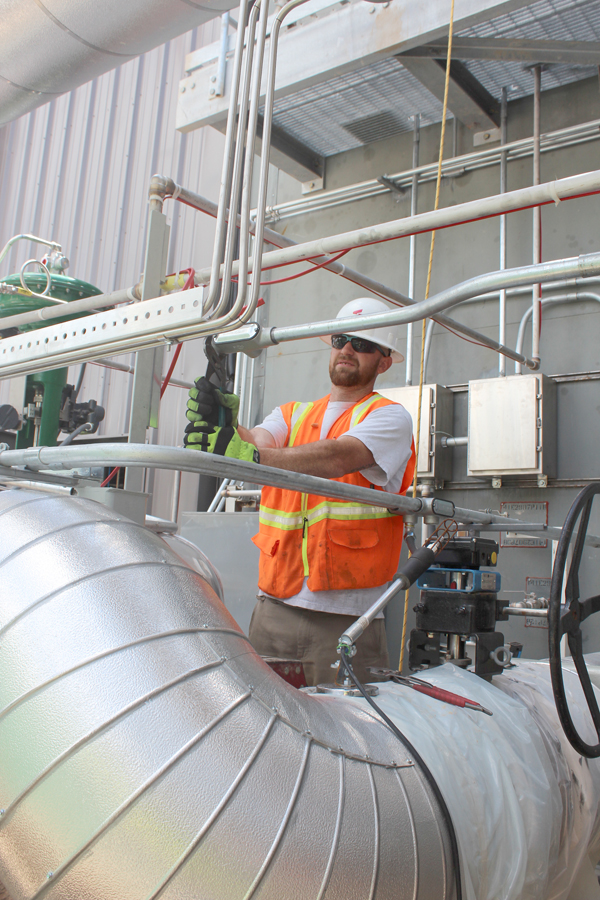Trades, Boldt fire up new plant for Wolverine Power
Date Posted: July 1 2016

ELMIRA TWP. - The recently announced closure of 15 coal-fired power plants in Michigan over the next several years isn't the state's only major power plant news. There's new, replacement power generation coming on line, too.
We refer to the electricity now being produced by the 410-megawatt Alpine Power Plant, whose construction was rapidly wrapping up when we visited in early June, preparing for the facility to become fully operational in early July. The natural-gas-fired facility has been erected over the past year in this community, about eight miles west of the Gaylord exit of I-75.
"This project has had a really tough timeline, and it wasn't without its challenges, but overall it's been a positive experience," said Brian Bejcek, project manager for the plant's owner, Wolverine Power Cooperative.
The peaking plant employs two simple cycle General Electric gas turbine units, rated at 202 megawatts each. Boldt Construction managed the project, which started with the clearing of forested land off of M-32 in April 2015. The plant's somewhat remote placement on an 80-acre site makes sense when you consider that it's only one-half mile from high voltage lines that will move the plant's power output, and less than a half mile from a pair of buried 36-inch TransCanada natural gas lines for the plant to tap into to meet its power needs. Plus, a railway line in Elmira Twp. facilitated the delivery of some of the plant's major, heavy components from out of state, like turbines, generators and transformers.
The site has sandy soil, which made it relatively easy to place the 50-foot-deep auger-cast grout pile foundations supporting the plant. Above ground, nearly the entire project was completed without a roof over anyone's head - and that's no small factor when the bulk of the work took place during a northern Michigan winter.
"We had a really good run of weather coming into January," Bejcek said. "It impeded us a bit when the snow started falling, but thankfully we had a very mild winter overall. The bigger challenge was managing the deliveries, and the guys working on top of each other in a fairly compact site."
At peak employment, about 350 Hardhats toiled on the project - some tradespeople commuted from home to the sparsely populated Gaylord area, some stayed in area hotels and motels during the week. They worked under a project labor agreement along with the contractors and owner. "Overall," Bejcek said, "we were satisfied with the PLA. It did what we wanted."
Bejcek said Wolverine, Boldt and building trades personnel all "had a lot of late nights" in the weeks before the plant was completed. "The support we had was really positive," he said. "It's been an aggressive schedule, and two months ago, we weren't sure if we'd meet the deadline, but they managed a good program, everybody stepped up, and here we are. Overall, a really good group of guys here."
Boldt Construction Project Manager Dave Rudolf said tasks in the last few weeks of the project were "filled with punch list items, and cleaning up loose ends."
Boldt had a major role in the project, including installation of the concrete substructures, equipment installations, structural steel and equipment enclosures. Boldt also self-performed the piping installations. Electrical, instrumentation and insulation installations were included in the Boldt scope and were provided by subcontractors.
Rudolf agreed with Bejcek that "it was a very challenging job in the time frame we were given. It's been one of the faster projects of this type that you've ever going to see, and the bulk of it was done in the winter."
Furthermore, Rudolf said that much of the mechanical and electrical work took place starting in January. "The trades did well," he said, "they put in a lot of hours, a lot of seven day weeks. It took a lot of energy to get this done." He said there was a challenge in getting some tradespeople to work at the site, especially in the spring, when there were significant projects going on downstate at the Consumers Energy Karn-Weadock and J.H. Campbell plants.
A few hours after the major milestone of the first Alpine unit being fired up was reached, Bejcek said, "some people on site were asking when the first unit would be fired up. They didn't realize it was up. It's very quiet." Keeping the noise down during the plant's operation has been a significant consideration for Wolverine.
Wolverine announced at mid-day on June 15 that the plant was fully powered and capable of providing enough electricity on the grid to nearly 120,000 homes, with the final commissioning process expected to follow. The Alpine facility is the seventh in Wolverine's fleet of power plants.
Wolverine Power Supply Cooperative, Inc. is a not-for-profit generation and transmission cooperative headquartered in Cadillac. Wolverine is owned by and supplies wholesale power to five distribution electric cooperatives: Cherryland Electric Cooperative, Grawn; Great Lakes Energy, Boyne City; HomeWorks Tri-County Electric Cooperative, Portland; Presque Isle Electric & Gas Co-op, Onaway; and Midwest Energy Cooperative, Cassopolis; and two alternative electric suppliers: Spartan Renewable Energy.
"I want to reiterate my praise for the Wolverine employees," said Eric Baker, president and CEO of Wolverine on June 15. "Power plant chiefs, operators, engineers, and technicians across Wolverine's system contributed essential skills and knowledge to bring us this far. In addition, Wolverine's engineering and operations personnel offered vital commissioning support to hunt down and fix a number of typical commissioning nuisances, and to prepare the transmission network for start-up."
According to Wolverine Power, the Alpine plant "is the largest and most efficient generator in Michigan north of the Ludington-Midland line, including the Upper Peninsula. The addition of Alpine to Wolverine's generation fleet helps ensure Wolverine's ability to provide clean, reliable, and affordable power supply to its members for years to come. Alpine is also a vital resource for Michigan as it faces a projected capacity shortfall in the coming years."
 CUTTING THREE-INCH-THICK insulation for a filter separator unit at the Wolverine Power Alpine Plant are (l-r) Rick Lavier and Jeremy Snyder of Heat and Frost Insulators Local 47. They’re employed by Allied Industrial Service.
CUTTING THREE-INCH-THICK insulation for a filter separator unit at the Wolverine Power Alpine Plant are (l-r) Rick Lavier and Jeremy Snyder of Heat and Frost Insulators Local 47. They’re employed by Allied Industrial Service.
 COOLING WATER PIPING at the Wolverine Power Alpine Plant gets the attention of Bob Schaub and Jason Weiksner of Plumbers and Steamfitters Local 85. They’re employed by Boldt.
COOLING WATER PIPING at the Wolverine Power Alpine Plant gets the attention of Bob Schaub and Jason Weiksner of Plumbers and Steamfitters Local 85. They’re employed by Boldt.

TIGHTENING a fitting at the Alpine Plant is Randy McKenzie of IBEW Local 498. He’s employed by Swan Electric.
